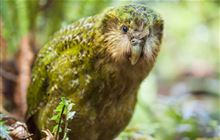Kākāpō population reaches a record high of 213
Archived content: This media release was accurate on the date of publication.
Introduction
It’s official – for the first time in more than 70 years, the kākāpō population is a record 213 birds.Date: 17 September 2019
The youngest chick of the bumper 2018/19 breeding season, Stella-3-B-2019, has today turned 150 days old – the age at which all chicks are deemed to be “juvenile” and officially added to the adult population.
DOC Kākāpō Recovery Science Advisor Dr Andrew Digby says this is an important milestone in the long journey towards kākāpō recovery.
“There are probably more kākāpō alive today than at any time in the last 70 years. Decades of work from many people has gone into achieving this.”
The 2018/19 breeding season was the biggest ever on record after a mast year lead to unprecedented amounts of rimu fruit which is necessary for kākāpō to successfully breed and hatch chicks on the main breeding islands.
A record 71 chicks survived through to juvenile age – far surpassing the previous record of 32
Ngāi Tahu representative to the Kākāpō Recovery Group Tane Davis says the success of this season has come from a huge joint commitment by all those involved.
“Utilising technology, local and international experts along with having the ability to predict high mast for rimu seed and fruit has led to this outstanding achievement.
“More kākāpō means finding more pest free habitat – this will be the next challenge, but one day being in a position to return kākāpō to their wahi kainga, places like Rakiura, is the ultimate goal.”
The breeding season has not been without challenges however, particularly after a wave of aspergillosis – a fungal infection that can be extremely deadly to birds – swept through the population living on predator free Whenua Hou/Codfish Island. Thankfully, thanks to the swift action by a dedicated team from DOC, Auckland Zoo, Massey Wildbase, Dunedin Wildlife Hospital and Wellington Zoo many of the 21 birds affected have so far survived. However, a recent death highlights that the disease remains an ongoing threat.
DOC kākāpō operations manager Deidre Vercoe says the new population milestone is a wonderful reward for everyone involved in this taonga species’ recovery.
“A huge amount of effort from many people around both New Zealand and the world has gone into achieving this remarkable result. This includes National Partner Meridian Energy who funded Smart Eggs and Assisted Breeding, international artificial insemination experts, vets and experts around the country who supported us through incubation, hand rearing and the aspergillosis crisis and hundreds of volunteers who’ve helped to keep both rangers and birds fed on the islands this breeding season.
“The fact that the milestone happened to fall in the middle of Conservation Week gives us another reason to celebrate.”
The next challenge will be looking for new homes for the growing kākāpō population to expand into, Deidre says.
“The kākāpō population has grown 70% in the last 5 years and we’re starting to reach carrying capacity on the two main breeding islands: Anchor and Whenua Hou. We need to find new suitable habitats for the growing population, which is a great problem to have.”
Contact
For media enquiries contact:
Email: media@doc.govt.nz

